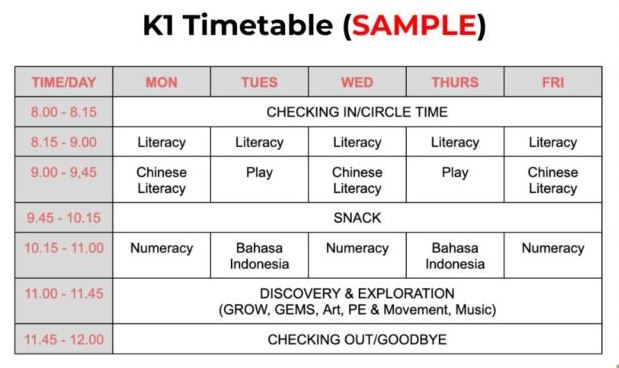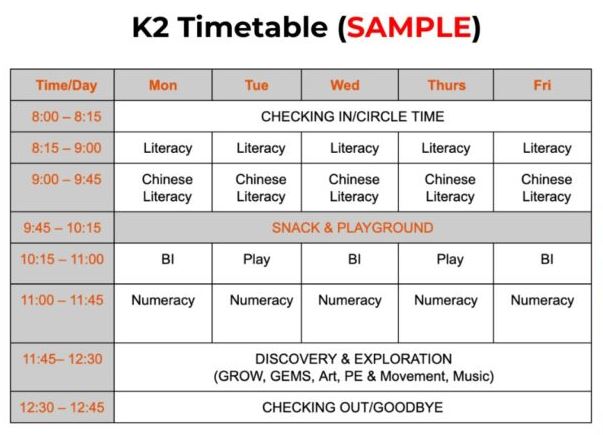The PIAGET Education experience for early learning is adapted from the Singapore Nurturing Early Learners Curriculum framework and outcomes, ensuring a solid foundation for lifelong learning.

Literacy Programme
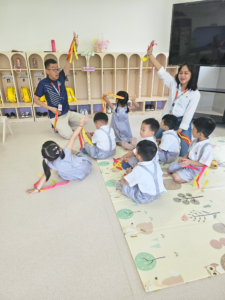 NationalHigh ELC employs the Jolly Phonics Programme to kickstart your child’s reading journey. Jolly Phonics is a dynamic, comprehensive and multi-sensory phonics programme that grows students’ skills in reading and writing. The program emphasises several core principles and practices. It is a synthetic phonics approach that focuses on teaching children the sounds of letters (phonemes) before blending them to form words. This systematic and structured approach helps children understand the relationship between letters and sounds.
NationalHigh ELC employs the Jolly Phonics Programme to kickstart your child’s reading journey. Jolly Phonics is a dynamic, comprehensive and multi-sensory phonics programme that grows students’ skills in reading and writing. The program emphasises several core principles and practices. It is a synthetic phonics approach that focuses on teaching children the sounds of letters (phonemes) before blending them to form words. This systematic and structured approach helps children understand the relationship between letters and sounds.
The programme focuses on 5 basic skills:
- Learning Letter Sounds : Children are taught 42 main letter sounds, which include alphabet sounds and digraphs such as “sh,” “ch,” and “th.”
- Learning Letter Formation: The program includes guidance on how to form each letter correctly, often using multi-sensory techniques like air writing, writing in sand or sandpaper letters.
- Blending: Students learn to blend sounds together to read words. This skill helps them read unfamiliar words.
- Identifying Sounds in Words: Activities help children identify and isolate sounds in words, aiding in spelling and phonemic awareness.
- Tricky Words: This part of the programme addresses irregular words that don’t follow typical phonetic patterns, teaching them as ‘tricky words’ or sight words.
Numeracy Programme
The NEL Singapore Numeracy Programme for Early learners focuses on building a strong foundation in basic mathematical concepts and skills. The curriculum emphasizes understanding and mastery of key concepts through hands-on activities, visual aids, and interactive learning.
Key topics:
- Counting and Number Sense:
-
- Counting: Understanding numbers up to 20 and beyond, recognizing number patterns and subitizing.
- Number Sense: Comparing, ordering, and understanding the value of numbers.
- Basic Operations: Introduction to basic single-digit addition and subtraction using concrete objects and visual representations.
- Basic Shapes and Simple Spatial Concepts:
-
- Geometry: Recognizing, describing and naming basic shapes (e.g., circles, squares, triangles).
- Spatial Awareness: Understanding concepts of size, position, and direction.
- Simple Relationships and Patterns:
-
- Patterns: Identifying, recreating, and creating simple patterns.
- Relationships: Understanding relationships between objects and sets, such as grouping and sorting.
Other Topics that will be covered
Measurement:
-
- Length, Weight, and Volume: Comparing and ordering objects by size, weight, and capacity by using non-standard units of measurement.
- Time: Recognizing daily routines using a timetable and home routines and understanding basic time concepts (morning, afternoon, evening).
Data Handling:
-
- Sorting and Classifying: Grouping objects based on attributes.
- Simple Graphs: Understanding in simple graphs (pictographs).
Teaching Strategies
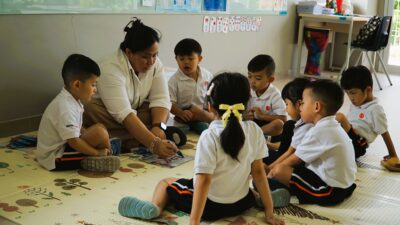 Concrete-Pictorial-Abstract (CPA): This approach ensures students first experience concepts through hands-on activities (concrete), then through pictures (pictorial), and finally through symbols and numbers (abstract).
Concrete-Pictorial-Abstract (CPA): This approach ensures students first experience concepts through hands-on activities (concrete), then through pictures (pictorial), and finally through symbols and numbers (abstract).
Problem-Solving: Engaging children in problem solving ensures that the they participate in sustained periods of thinking, which is a key component of good Mathematics skills. This will teach them to seek solutions and answers for their problems and questions.
Play-Based Learning: Engaging students through play and exploration to develop mathematical understanding naturally.
Interactive and Visual Learning: Using manipulatives, visual aids, and interactive activities (such as asking questions, using stories, songs and rhymes) to make learning engaging and effective.
The NEL Numeracy Programme aims to create a supportive and engaging environment that encourages students to explore and enjoy Mathematics. It focuses on developing confidence and positive attitudes toward Mathematics by fostering curiosity and interest in exploring concept. The goal is to build a strong foundation to strengthen their understanding for future learning in the subject. By nurturing these key elements, the curriculum lays a solid groundwork for children’s future educational journey in Mathematics.
Teaching method and activities:
To reinforce learning, Jolly Phonics uses various sensory experiences, including. But not limited to visual (letter shapes), auditory (sounds), kinesthetic (movements), and tactile (touch) activities.
For example, a specific action is assigned to each sound, helping children remember them as they do the action. The programme also includes songs and stories that incorporate the letter sounds, making learning enjoyable and memorable for young children. Teachers use a range of interactive tools and resources, such as flashcards, posters, puppets, and digital resources, to engage children and support diverse learning styles. Jolly Phonics includes both group-based and individual activities, allowing children to practice phonics skills through games, worksheets, collaboration and hands-on activities. The programme’s pace is flexible, catering to different learning speeds, and teachers can provide additional support or advanced activities as needed for differentiation.
Teaching method and activities:
Classroom Implementation:
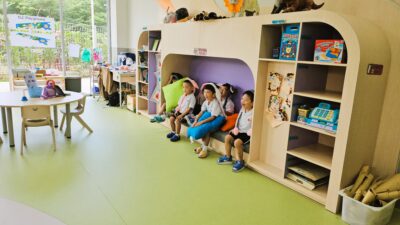
- Daily Sessions:
– Phonics instruction is typically conducted in daily sessions, where children practice the five basic skills in a structured manner.
- Integration with Other Subjects:
– Phonics skills are integrated into other areas of learning, such as reading time, writing activities, and even subjects like science and social studies, reinforcing the application of phonics in various contexts.
- Assessment and Progress Monitoring:
– Teachers regularly assess children’s progress through both formal and informal assessments, ensuring that each child is developing their phonics skills effectively.
By focusing on strengthening the foundational skills of reading and writing, Jolly Phonics helps children develop strong literacy skills, preparing them for more advanced literacy instruction in later grades. The multi-sensory and interactive nature of Jolly Phonics keeps young learners engaged and makes the process of learning to read and write engaging. As children master phonics skills, they become more confident and independent readers and writers, fostering a positive attitude towards literacy.
Discovery of the World
 NationalHigh and the NEL are in one the belief that children are natural learners and that they construct knowledge through inquiry. Combining the educational theories of John Dewey and Erik Erikson provides a robust framework for inquiry-based learning in kindergarten. By emphasizing experiential learning, through hands-on activities and real-life experiences where children actively participate in their learning process while focusing on the importance of social interaction and emotional growth, this approach focuses on problem-solving and critical thinking, encouraging children to pose questions and explore solutions, while also promoting reflection to deepen their understanding.
NationalHigh and the NEL are in one the belief that children are natural learners and that they construct knowledge through inquiry. Combining the educational theories of John Dewey and Erik Erikson provides a robust framework for inquiry-based learning in kindergarten. By emphasizing experiential learning, through hands-on activities and real-life experiences where children actively participate in their learning process while focusing on the importance of social interaction and emotional growth, this approach focuses on problem-solving and critical thinking, encouraging children to pose questions and explore solutions, while also promoting reflection to deepen their understanding.
This means fostering trust and autonomy, supporting children’s natural curiosity, and encouraging exploration and initiative within a supportive environment.
Lessons in Discovery the World will be instrumental in supporting and developing these essential skills in children. In Discovery the World the students will engage themselves with the natural world and explore different themes to form new knowledge within themselves.
Building Essential Skills
The programme focuses on building essential skills:
- Observing: is the process of examining and noticing details using their five senses to gather information and understand their surroundings better. The students will fully immerse themselves in the experience of learning.
- Comparing and Classifying: The students will look at similarities and differences in their observations to organize items into groups.
- Sequencing: The students will learn to recognize patterns of change in people, objects, and the environment over time and reflect on these patterns and why they happen.
- Questioning: Although many children love to ask questions about things they are interested in or curious about, some children may struggle to think of or formulate their questions, the teacher will act as a facilitator to help them design meaningful and inquiry ready questions. Asking questions encourages students to explore and learn about the world around them, fostering their sense of wonder and curiosity while also developing critical thinking skills.
- Investigating: The process of investigation involves asking questions, making predictions, and testing ideas. Students will find answers through various methods such as experimenting, interviewing experts, consulting books, magazines, multimedia sources, and going on field trips.
- Inferring and Predicting with Reasoning: Students will draw conclusions or explain phenomena based on their findings, observations, presented information, and prior knowledge or experiences.
- Recording, Drawing Conclusions and Communicating Discoveries: By documenting their findings through mark-making, drawing, writing, or taking photos, videos, or audio clips, children become more precise in their observations. This attention to detail helps them process and make sense of gathered information to form
opinions or conclusions.
 Areas of Exploration
Areas of Exploration
- People and Cultures
- Places and Spaces
- Time and Events
- Natural and Built Environments
- Inventions and Technology
By integrating these approaches, an inquiry-based learning curriculum for kindergarten would involve providing hands-on activities, encouraging curiosity, and facilitating group work to support social development. Problem-solving tasks and reflective practices would be central to developing critical thinking and understanding. Overall, this combined approach ensures a holistic development, addressing both cognitive and emotional growth, creating a safe and supportive learning environment that fosters trust, independence, and a sense of competence in young learners.
Time-Table
